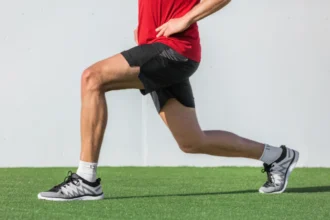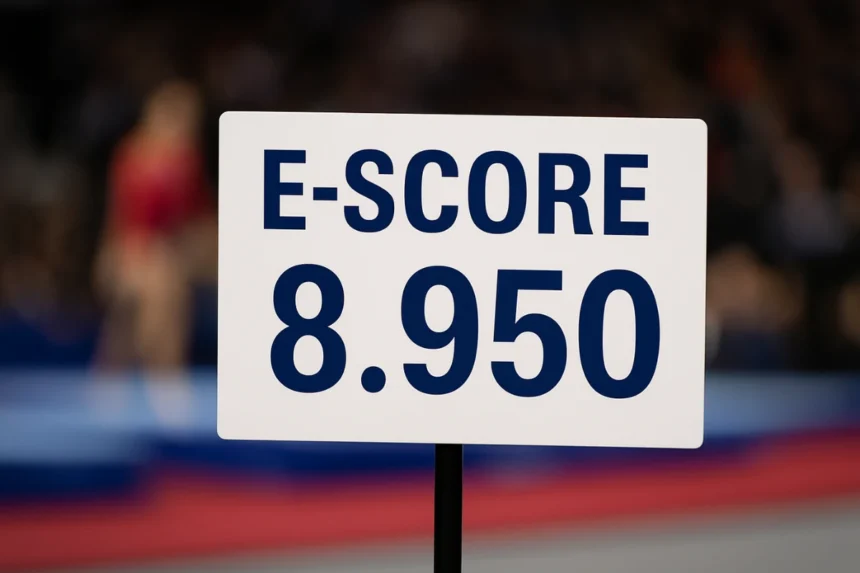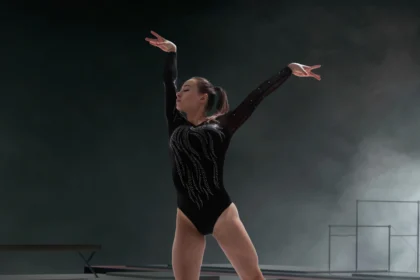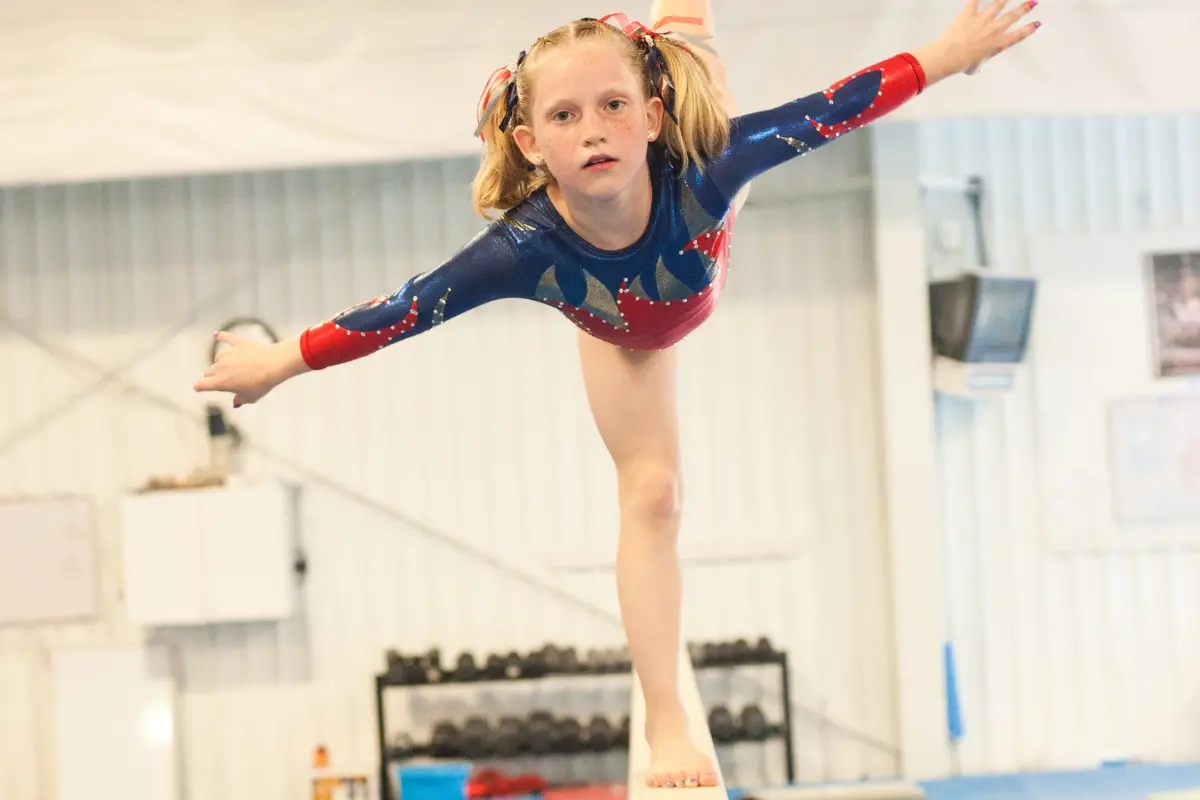In artistic gymnastics, the Execution Score (E-score) reflects how cleanly and artistically a routine is performed. While the D-score rewards difficulty, the E-score rewards quality.
What Is the Execution Score?
The Execution Score starts at a perfect 10.0. Judges then deduct points for form, technique, rhythm, and artistry errors. These deductions are subtracted from the 10.0 base to produce the E-score. The goal for every gymnast is to minimize deductions as much as possible while delivering a clean, aesthetically pleasing routine.
Who Determines the E-Score?
Each routine is reviewed by an Execution Panel, usually five judges at the international level (such as the Olympics or World Championships). In some competitions, especially at lower levels, there may be two or three execution judges.
The judges score independently. The highest and lowest E-scores are dropped for five-judge panels, and the middle three are averaged. This process helps eliminate bias or outlier opinions.
What Do Judges Actually Deduct?
Execution judges follow a structured system that evaluates every aspect of a gymnast’s performance. Each routine begins with a perfect 10.0, and deductions are applied based on five major quality themes.
1. Body Line and Position
Judges expect straight, tight body lines unless the skill specifically requires bending. Deductions are taken for:
- Leg separation (in flight or handstands)
- Bent arms or knees
- Piked or arched body positions when a straight line is expected
- Improper hip or shoulder angles
These errors disrupt the aesthetic and technical precision of the routine.
2. Amplitude and Dynamics
Big skills should be performed boldly. Judges reward height, distance, and energy. They deduct for:
- Low flight on tumbling passes, vaults, or release moves
- Weak push-off from the vault table
- Lack of explosive energy in saltos and dismounts
Amplitude reflects how much power the gymnast brings to their performance.
3. Precision of Technique
Gymnastics isn’t just about completing skills—it’s about doing them correctly:
- Handstands on bars must finish within 10 degrees of vertical
- Twisting elements must show clear, controlled closure
- Dance turns should finish on relevé with stable posture
- Acrobatic elements must show clean, intentional execution
Any wobble or imprecision can result in a 0.10–0.30 deduction.
4. Rhythm and Continuity
Routines should flow smoothly without awkward pauses or stalling:
- Extra swings on bars or beam
- Stops before tumbling passes
- Slow transitions or broken connections
- Choppy movement or lack of fluidity
Interruptions to rhythm reduce the impression of mastery and control.
5. Landing Quality
Landings are heavily scrutinized and have specific penalties:
- Small hop: −0.10
- Large step (more than shoulder-width): −0.30
- Deep squat or hand touch: −0.50
- Fall (including hands/knees on the mat): −1.00
Landing well is one of the clearest ways to preserve points—and one of the easiest places to lose them.
Special Notes by Apparatus
- Vault: Although the execution process is the same (start at 10.0, deduct), vaults all share the same D-score for a given vault type. The E-score then determines ranking among vaults of equal difficulty.
- Pommel Horse & Rings (MAG): Men’s apparatus have some apparatus-specific deduction criteria (e.g., shoulder angle on rings), but the panel averaging remains identical.
Artistry Has Its Own Mini-Scale
In the 2025–2028 Code of Points, the Women’s Technical Committee introduced a more structured approach to evaluating artistry. Instead of vague deductions, artistry faults now follow the same standardized ladder used for technical errors: 0.10 for small faults, 0.20 for medium, and 0.30 for large.
This shift allows judges to distinguish between routines that are slightly lacking in expression and those that are significantly disconnected from the music or choreography. For example:
- A routine with repetitive movements or flat emotional engagement might earn a 0.10 deduction.
- A routine that feels musically disconnected or lacks level variation throughout could receive a 0.20.
- A performance that shows no artistic intention or engagement may see the full 0.30 taken.
This change helps reward genuine performance quality, not just technical precision.
In Summary
| Theme | Typical errors judges watch for | Size guide* |
|---|---|---|
| Technique & Form | bent arms/knees, separated legs, flexed feet | 0.10 – 0.50 |
| Amplitude & Extension | low flight on release, incomplete split angles, short handstand | 0.10 – 0.30 |
| Body Alignment & Posture | arched handstand (“banana”) on bars, pike down on saltos | 0.10 – 0.50 |
| Artistry & Rhythm (WAG beam/floor) | monotone dance, poor musicality, lack of expression | 0.10 – 0.30 |
| Landing | small hop 0.10, large step 0.30, deep squat 0.50, fall 1.00 | 0.10 – 1.00 |
*Guides are typical WAG/MAG values; each apparatus has a detailed table.
Per-element ceiling. New for the 2025-2028 cycle, if the gymnast stays on the apparatus the maximum execution deduction on one element is 0.80; only a fall triggers the full 1.00.
Source: gymnastics.sport
Combining E-Score with D-Score
Once the E-score is finalized, it is simply added to the gymnast’s D-score (the open-ended tally of difficulty, composition requirements, and connection bonuses) to yield the gymnast’s final routine score:
Final Score = D-score + E-score − Neutral Deductions (if any)
Neutral deductions (e.g., time violations, attire infractions) are then subtracted after the D + E subtotal.
What Makes a High E-Score?
- Clean form: Few or no visible mistakes—straight legs, pointed toes, and good posture.
- Solid landings: No steps, hops, or wobbles.
- Smooth flow: Everything connects well, with no pauses or breaks.
- High and powerful skills: Moves look big and confident.
Scoring above 9.0 shows excellent control and presentation. Scores above 9.5 mean the performance was almost perfect—rare and impressive!
E-Score Example: Women’s Floor Routine (Paris 2024)
Let’s break down Simone Biles’ floor routine from the Paris 2024 Olympics, judged under the 2022–2024 Code of Points but reflective of many principles that continue into the 2025–2028 cycle.
Routine Summary:
- Difficulty Score (D-score): 6.900
- Execution Panel: 5 judges
- E-score starts at: 10.000 per judge
Execution Deductions Observed (estimated):
- Step out of bounds → neutral deduction −0.30 × 2 = −0.60
- Small hops on landings → −0.10 × 2 = −0.20
- Leg separation during leaps → −0.10
- Bent knees during tumbling → −0.10
- Slight loss of control on final pass → −0.30
- Dance turn not fully completed on relevé → −0.20
💡 Estimated execution deductions: ~2.167 points across the middle 3 judges
Judges’ E-Scores Submitted (reconstructed):
| Judge A | Judge B | Judge C | Judge D | Judge E |
|---|---|---|---|---|
| 7.90 | 7.85 | 7.80 | 7.75 | 7.70 |
- Drop the highest (7.90) and lowest (7.70)
- Average the middle three: (7.85 + 7.80 + 7.75) ÷ 3 = 7.800
(Official score reported: 7.833, suggesting slightly different values, but within this range)
Final Score Breakdown:
- D-score: 6.900
- E-score: 7.833
- Neutral deductions: −0.600 (step out of bounds x2)
✅ Final Score = 6.900 (D) + 7.833 (E) – 0.600 (Neutral) = 14.133
Discipline- and Level-Specific Notes
In all types of gymnastics, the execution score starts at 10.000. But what judges look for—and how they take off points—can vary depending on the discipline and level of competition.
Men’s Artistic Gymnastics (MAG)
- Like women’s gymnastics, routines start from 10.000.
- Instead of artistry, judges take presentation deductions for things like posture, control, and rhythm.
- On pommel horse, special attention is given to smoothness and rhythm between skills.
Developmental and NCAA Competitions
- In the USAG Development Program, a skill can’t lose more than 1.0 point, even if there are multiple mistakes in it.
- Compulsory routines have set deduction charts for each required skill.
- In college gymnastics (NCAA), four execution judges are used, and all four scores are averaged—unlike elite meets, where the highest and lowest are dropped.
Rhythmic, Trampoline, Acrobatic, and Aerobic Gymnastics
These disciplines also use a 10.0 execution base, but judges focus on different things:
- Rhythmic: Judges watch for grace, flexibility, and how well the gymnast handles the apparatus (like ribbons or hoops).
- Trampoline: Focus is on height, control, and landing stability.
- Acrobatic: Deductions are based on teamwork, timing, and how cleanly lifts and balances are done.
- Aerobic: Judges look at energy, sharp movements, and how well the group moves in sync.
This system allows each discipline and level to focus on what matters most for its unique style, while still rewarding clean and confident performances.













